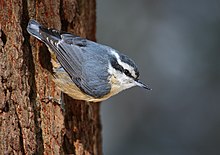Red-breasted nuthatch
| Red-breasted nuthatch | |
|---|---|
 |
|
| Female | |
| Scientific classification | |
| Kingdom: | Animalia |
| Phylum: | Chordata |
| Class: | Aves |
| Order: | Passeriformes |
| Family: | Sittidae |
| Genus: | Sitta |
| Species: | S. canadensis |
| Binomial name | |
|
Sitta canadensis Linnaeus, 1766 |
|
The red-breasted nuthatch (Sitta canadensis) is a small songbird. The adult has blue-grey upperparts with cinnamon underparts, a white throat and face with a black stripe through the eyes, a straight grey bill and a black crown. Its call, which has been likened to a tin trumpet, is high-pitched and nasal. It breeds in coniferous forests across Canada, Alaska and the northeastern and western United States. Though often a permanent resident, it regularly irrupts further south if its food supply fails. There are records of vagrants occurring as far south as the Gulf Coast and northern Mexico. It forages on the trunks and large branches of trees, often descending head first, sometimes catching insects in flight. It eats mainly insects and seeds, especially from conifers. It excavates its nest in dead wood, often close to the ground, smearing the entrance with pitch.
Like all nuthatches, the red-breasted nuthatch is assigned to the genus Sitta (Linnaeus, 1758), a name derived from sittē (σίττη), the Ancient Greek word for the Eurasian nuthatch. The specific epithet canadensis is New Latin for "belonging to Canada". The species was given its scientific name by Carl Linnaeus in 1766, based on a specimen collected in Canada. "Nuthatch" is a linguistic corruption of "nuthack", referring to the bird's habit of wedging nuts into cracks in tree bark and hacking at them until they break open. "Red-breasted" is a reference to the rusty colour of the male's underparts.
In the past, the red-breasted nuthatch and four other species — the Corsican nuthatch, the Chinese nuthatch, the Algerian nuthatch and the Krüper's nuthatch — were thought to be a single species. These five make up a well-defined species group known as the "Sitta canadensis group", and are sometimes considered to be a superspecies. Within the species group, DNA studies have shown that the red-breasted nuthatch, the Corsican nuthatch and the Chinese nuthatch make up one clade and the Algerian nuthatch and Krüper's nuthatch make up a sister clade. The red-breasted nuthatch is monotypic across its extensive range.
...
Wikipedia

